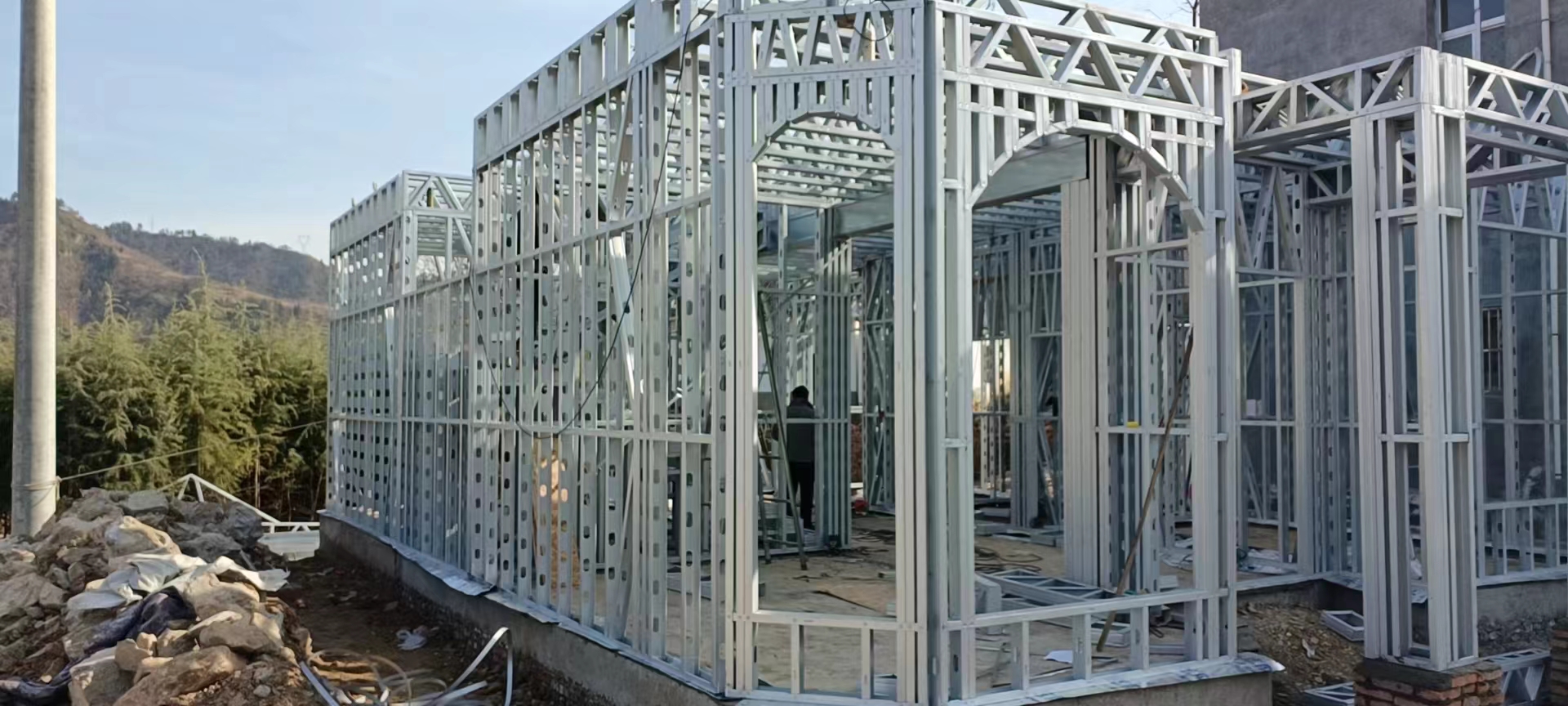What material is used for the steel frame of a light steel villa?
2024-07-16 21:08

1.Overview
The framework of a light steel villa is a critical component in the building structure, primarily used to support walls, roofs, and other parts of the building, ensuring its stability and durability. As a modern residential construction form, the light steel villa has garnered increasing attention due to its efficiency, environmental friendliness, and cost-effectiveness. In the construction of light steel villas, the framework, being a vital part of the structural system, significantly affects the building’s performance and lifespan through its material, design, and construction quality.
2.Materials Used in Light Steel Villa Framework
The framework of a light steel villa is mainly composed of cold-formed steel sections, which are typically made from high-strength hot-rolled galvanized steel plates or cold-rolled steel sheets. Here’s a detailed introduction to some commonly used materials:
(1) Cold-formed Steel Sections
Cold-formed steel sections are steel plates that are processed into various cross-sectional shapes through cold bending processes at room temperature. These sections have the following characteristics:
•Material: Typically made from hot-rolled galvanized steel plates or cold-rolled steel sheets. Galvanized steel plates have a layer of zinc coating that effectively prevents oxidation and rust, enhancing durability.
•Strength: They have high tensile and compressive strength, making them suitable for bearing various loads in building structures.
•Processing Techniques: Various cross-sectional shapes are formed through processes like rolling, punching, and bending, such as C-sections, Z-sections, and U-sections.
(2) High-strength Steel
To improve the load-bearing capacity and durability of the framework, high-strength low-alloy steel (HSLA) is often used in light steel villa frameworks. This steel is enhanced by adding small amounts of alloying elements (such as manganese, nickel, and vanadium) to improve performance.
•Materials: Common standards include Q195, Q235, Q345, etc.
•Characteristics: High strength, high toughness, and excellent plasticity and ductility, meeting the high performance requirements for building structures.
(3) Hot-dip Galvanized Coating
To prevent steel corrosion, the framework of a light steel villa usually has a hot-dip galvanized coating.
•Galvanizing Process: Steel plates are immersed in a zinc bath to form a protective zinc layer that bonds with the steel.
•Effectiveness: Provides excellent corrosion resistance and extends the structural lifespan.
3.Types and Specifications of Light Steel Villa Framework
The framework system of a light steel villa includes various types of steel sections and connectors. There are numerous types and specifications, with some common ones listed below:
(1) C-sections
•Usage: Commonly used for the wall and roof framework in light steel villas.
•Specifications: Common specifications include C80, C100, C120, indicating parameters like flange width and web height.
(2) Z-sections
•Usage: Primarily used for the roof truss system in light steel villas.
•Specifications: Common specifications include Z100, Z150, Z200, known for high load-bearing capacity and stability.
(3) U-sections
•Usage: Used to support and connect different structural components.
•Specifications: Typically used for support beams or connection beams in light steel structures.
(4) Steel Framework Accessories
Includes various connectors, supports, bolts, nuts, etc., used for fixing and connecting different parts of the framework.
4.Design and Construction of Light Steel Villa Framework
(1) Design Principles
When designing the framework system for a light steel villa, the following principles should be followed:
•Load-bearing Capacity: The framework must meet the design load requirements to ensure structural safety.
•Stability: Design must consider the framework’s stability to prevent deformation during construction and use.
•Corrosion Resistance: High-quality galvanized steel or coating technologies should be chosen to prevent corrosion over time.
(2) Construction Techniques
The construction process for the framework of a light steel villa generally includes the following steps:
•Material Inspection: Check the specifications and quality of the framework materials to ensure they meet design requirements.
•Framework Installation: Cut, connect, and install the framework according to design plans, ensuring that each connection point is secure and reliable.
•Wall Assembly: Install wall panels, insulation layers, and waterproof layers onto the framework.
•Inspection and Acceptance: After construction, perform inspections to confirm the quality of the framework system.
5.Future Applications of Light Steel Villa Framework
(1) Environmental Protection and Sustainability
Light steel villas use cold-formed steel as a primary structural material, which has lower energy consumption in production and the steel is recyclable, aligning with modern environmental building concepts.
(2) Building Efficiency
The lightweight and high-strength characteristics of light steel villa frameworks make construction faster and more cost-effective, reducing construction time and labor costs.
(3) Design Flexibility
The light steel framework system offers great design flexibility, accommodating various architectural styles and functional needs.
(4) Seismic Performance
Light steel villas have excellent seismic performance, providing higher safety in natural disasters such as earthquakes.
(5) Market Demand
As people’s focus on housing quality, comfort, and environmental friendliness increases, the market demand for light steel villas is growing, with promising future development prospects.
6.Conclusion
The materials for the framework of a light steel villa primarily include cold-formed steel sections, high-strength steel, and hot-dip galvanized coatings, which together provide stable support for the structure of the villa. The design and construction quality of the framework system are crucial to the building’s overall performance. With ongoing technological advancements and increasing environmental requirements, light steel villas are expected to play a more significant role in the future construction market.
By thoroughly understanding the materials used in light steel villa frameworks, we see that this construction technology not only sets high standards in material selection but also demonstrates extensive potential in construction techniques and future applications. As technology evolves and market conditions change, light steel villas will continue to innovate and meet the demands of modern construction.



